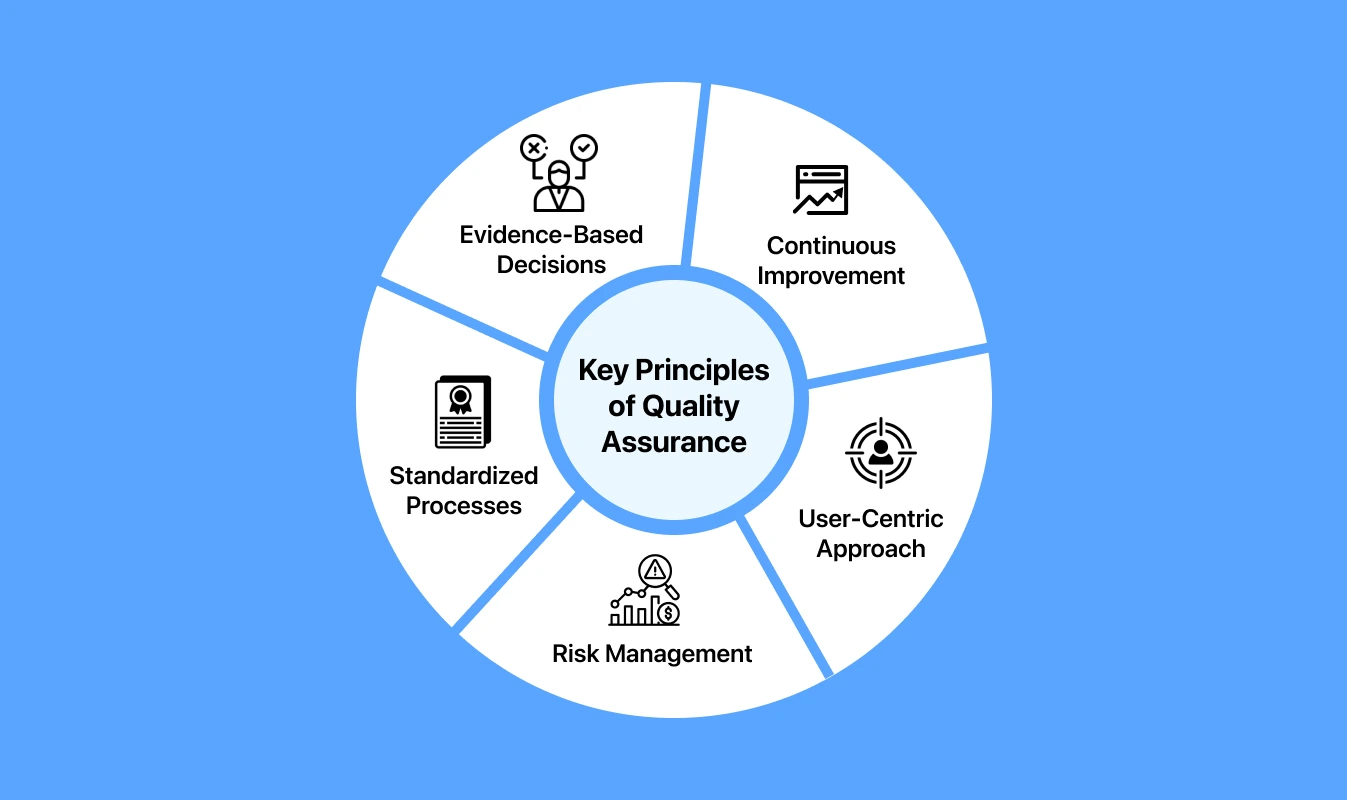The demands for speed and quality have drastically changed the way we approach software development. Agile methodologies have changed this landscape, replacing rigid and linear workflows with adaptive, iterative processes.
In this new dynamic, Quality Assurance (QA) no longer operates as an isolated checkpoint—it’s an integral part of the development cycle. Every sprint, every iteration, demands consistent testing and feedback to ensure that what’s delivered is not just functional but robust.
Test automation plays a pivotal role in meeting these demands. Manual testing, while essential in certain contexts, simply cannot keep up with Agile’s speed and need for frequent releases. Automation enables teams to validate new features, detect regressions, and deliver reliable software at scale. It’s not just about saving time—it’s about building confidence in every release.
The Role of Quality Assurance in Agile Frameworks
Quality assurance, at its very core, needs to be about meeting requirements against the expected workability of the product. In the Agile approaches of Scrum or Kanban, continuous QA represents the opposite of stop-and-check at the end of the development cycle in that activities now embed rather than stand independent of development activities. This transition is essential, as Agile emphasizes regular iterations and incremental deliveries.
Understanding the shift from traditional QA practices to Agile is crucial. Traditional methods might involve extensive documentation and staged testing after most development is complete, leading to delayed feedback. Agile, in turn, tries to provide testing and feedback loops very often. Frequent involvement provides not only early bug detection but also more collaborative processes for developers, testers, and stakeholders.
The Importance of Test Automation in Agile
So, why is test automation particularly beneficial in Agile frameworks? With Agile’s rapid iterations, using manual testing processes alone can lead to bottlenecks. Test automation supports continuous testing, allowing for quick validation of new features after each development cycle. It’s about enabling teams to deliver faster while still upholding high-quality standards.
Also, with automated testing, the teams can be certain that the tests are realized the same. Automating tests which will be reused repeatedly during the iterative process of developing software, ensures that new defects have not been introduced by changes made to a product or a software system. This dependability entails negligible risk of regressions and increased robustness in general terms about the software, a quality quite essential when working at a fast pace.
Key Principles for Implementing Test Automation
When implementing test automation, consider incorporating the following principles:
Prioritize Critical Test Scenarios: Identify and automate the most critical test scenarios that impact user experience and functionality. These tests should cover essential features and high-risk areas, ensuring immediate feedback on core functionalities.
Shift Left Incorporate Testing Early: Test activities should be included early on in the development process. The term “Shift Left” portrays that identification of defects could be done more in earlier stages, meaning less cost and time consumed from the very later cycle when fixing the defects.
Continuous Integration (CI)/Continuous Deployment: This approach may include integrating automated tests within a CI/CD pipeline. This will run an automated test for every code commit and result in the faster release of more reliable builds.
Leveraging LambdaTest for Effective Test Automation
Levering cloud-based testing platforms like LambdaTest is beneficial, this platform allows you to run automation across multiple browsers simultaneously. LambdaTest is an AI-powered test execution platform that allows you to run manual and automated tests at scale across 3000+ browsers and OS combinations. With this platform, QA teams and run various test scenarios simultaneously across multiple browsers and also use various testing frameworks to execute your tests seamlessly.
Suppose that your development team just integrated a new feature in some web application. LambdaTest will let the team use its strong automated testing to ensure that the newly developed feature works fine across a set of browsers and operating systems. This not only saves time but also provides much more reliability for the product when it reaches the end customer.
LambdaTest supports various frameworks and programming languages, making it adaptable for diverse tech stacks. Integration with CI/CD tools means you can set up your tests to run automatically, providing instant feedback whenever new code is pushed. This level of integration supports Agile teams in maintaining a swift pace without compromising on quality.
Key Components of Test Automation Strategies
As teams embark on the journey to implement test automation within Agile, several crucial components require attention to maximize its effectiveness:
- Test Design: Design your automated tests with clear objectives in mind. Each test case should have a precise goal and expected outcome. It’s essential to use test scenarios wisely, ensuring they cover not just functionality but also performance and security aspects, as these elements can often be overlooked.
- Maintainability: The automation scripts should be maintainable. Frequent refactoring might be required because of application changes; hence, it is very important to keep your automated tests clean and well-structured. Following best practices like naming conventions, modularity, and comments will enhance maintainability significantly.
- Environment Management: Consistent testing environments are vital for accurate results. Utilize container technologies like Docker to replicate production-like environments for testing purposes. This consistency helps reduce discrepancies between testing and production.
- Metrics and Reporting: Collect and analyze data from automated tests. Such information is invaluable in identifying patterns, optimizing strategies for testing, and communicating the status of quality to stakeholders. Metrics on pass/fail rates of test cases, defect density, and response times highlight the overall health of the software.
Real-World Examples of Automation Success in Agile
Consider the case of a popular e-commerce platform that struggled with manual testing processes. Each new sprint introduced numerous features, but the manual testing team could not keep pace, leading to missed bugs and customer complaints.
Therefore, with the implementation of the different measures in test automation with LambdaTest, critical test scenarios such as user login and checkout processes, including those to do with payment gateways, were automated. Resulting from this, days and a heap of manual effort over regression testing times were reduced to merely a few hours, hence creating room for more frequent releases without compromising on quality. Automation provided confidence in their releases and improved customer satisfaction significantly.
Similarly, a fintech startup adopted test automation late in its development cycle. Initially, their manual testing processes were cumbersome, and they feared introducing new features without thorough vetting. They began to automate their most-used functionalities and integrated these into a CI/CD pipeline using LambdaTest. The result? They could deploy new features to their users faster while maintaining a robust quality assurance process that addressed security vulnerabilities—imperative in the fintech sector.
Navigating Challenges in Test Automation
The allure of test automation in Agile development is undeniable—it accelerates testing, enhances accuracy, and ensures consistent quality. However, its implementation is not without challenges. Overcoming these obstacles is crucial for teams to unlock the full potential of automation.
- Initial Investment: One of the most significant barriers to adopting test automation is the upfront cost. Developing a robust automation framework demands substantial time, effort, and resources. Teams must invest in tools, infrastructure, and the expertise required to build and maintain the framework. Resistance can also stem from a preference for established manual processes, where comfort and familiarity often outweigh the perceived benefits of automation. To navigate this, organizations need to clearly communicate the long-term advantages of automation, such as reduced testing cycles and higher efficiency.
- Skill Gaps: Automating tests is a technical process that requires specialized knowledge. Most teams possess competency gaps either because of experience with coding or automation tools. This gap is bridgeable either through upskilling the existing team members with training or recruiting professionals who possess experience in test automation. Although these measures demand more resources, they’re essential for building a viable and effective automation strategy.
- Tool Selection: The plethora of automation tools available can be overwhelming. Selecting the right tool for your specific tech stack and requirements is a critical decision. Teams should conduct thorough evaluations, considering factors like integration capabilities, ease of use, scalability, and cost, to ensure the tool aligns with their goals and workflow.
Addressing these challenges proactively can pave the way for successful test automation adoption and enable teams to fully embrace Agile methodologies.
Future Trends in Quality Assurance and Test Automation
As we move forward, several trends are shaping the future of quality assurance:
- AI and Machine Learning: AI is slowly creeping in to take a big role in software test automation. AI will automatically select the test scenarios based on historical data, by which the testing effort shall be optimized and reduce the running time.
- Shift Right Testin: The focus is starting to shift from just early testing to including end-user feedback in the testing process. This trend emphasizes continuous validation, ensuring that user experiences remain central.
- DevOps and Continuous Testing: The blending of development and operations practices is becoming more prevalent. In such environments, quality assurance becomes a collaborative effort across teams, further promoting rapid delivery cycles while maintaining high standards.
- Cloud-Based Testing: Similar to what platforms like LambdaTest offer, there is a growing inclination towards cloud-based testing solutions. They provide vast flexibility in scaling testing environments, offering easy access to numerous devices and browsers.
- Focus on Security Testing: With cyber threats becoming more advanced, integrating security testing in the CI/CD pipeline is essential. Incorporating automated security tests helps identify vulnerabilities early in development.
Conclusion
Assuring the quality of a product using test automation in an Agile development environment is a necessity today rather than an option. Software teams leverage tools such as LambdaTest in their pursuit of effective strategies to meet software quality without losing speed. Recognizing the shifting landscape towards low-code solutions or cloud-based testing allows teams to adapt and thrive.
Embracing these methodologies and trends will empower organizations to foster a culture of continuous improvement and quality, ensuring they are well-equipped for the future of software development.














Leave a Reply